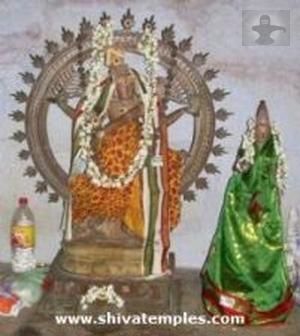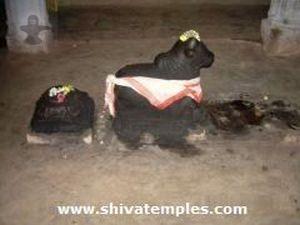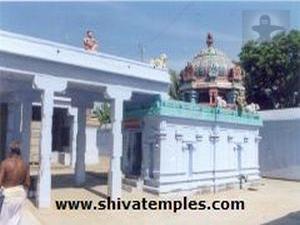Temple Layout - The nomenclature of this 'Paadal Petra Shivasthalam' cane be traced back to the time of the 'thevara pathikam'. During this period, the temple was referred to by the name of the local area, Kurukaavur, as well as the name of the temple itself, Velladai. Over time, the location has become more widely known as Tiru-kadaavur. This temple, though lacking an imposing gopuram, or gateway tower, is no less significant, comprising a single, well-defined prakaram, or outer enclosure. Visitors access the temple grounds through a simple, unassuming eastern entrance. At the heart of this sacred space lies the 'swayambhu linga', the self-manifested idol of the presiding deity, Velvidai Nathar. This sacred lingam rests upon a square 'Avudayar', or altar, with a relatively small 'Banam', oriented towards the east. Accompanying the primary deity is the female consort, Kaviyankanni Ammai, whose sannidhi faces southward. The temple also houses the 'Goshta Murtha's, or subsidiary deities, including Dakshinamurthy, Lingothbhavar, Brahma, and the fierce Goddess Durga. Reflecting the dual worship of Shiva and Vishnu common to many Shiva temples, there is a dedicated sannidhi for Kariya Maanikka Perumal. The pathway circumambulating the sanctum showcases a pantheon of sannnidhis and deities; the primary four Nayanmars, the cosmic dancer Nataraja, Kasi Viswanathar and his consort Visalakshi, Saneeswaran, 'Maavadi' Vinayaka, Shiva-loka-Nathar, Bhairavar, the sun deity Surya, Mari-Amman, and Sri-Iyanar. Notably, the temple also houses a unique sanndhi dedicated to Muruga, with the unconventional orientation of facing southward rather than the typical eastward direction. This distinctive positioning imbues Muruga with the aspect of a spiritual guide 'guru', leading to special Thursday poojas, or rituals.
Sundarar arrived here weary and parched, his entourage in tow after a long and arduous journey. Fatigued from the rigors of travel, they were in desperate need of sustenance and respite. Manifesting as an Andhanan, Shiva swiftly arranged meal and water to revive the travel-worn pilgrims. With great reverence, Sundarar partook of the nourishing meal, his hunger and thirst abated, before settling down to a peaceful slumber. Yet, when the saint awoke, he found that the entire wondrous arrangement, along with the enigmatic "andhanan" who had so graciously provided for their needs, had vanished without a trace. It was then that the truth dawned upon Sundarar - Lord Shiva himself had manifested to attend to their basic requirements. Filled with profound gratitude and awe, Sundarar made his way to the temple, where he sang a "pathikam" or hymn, praising the divine compassion of the deity. This miraculous event is commemorated annually on the full moon day of the Tamil month of Chitrai, known as Chitra Pournami. It is believed that by offering prayers and seeking the blessings of this deity, one can be spared from the scourge of hunger and food scarcity.
Tirugyanasambandhar in his tireless efforts to promote and solidify the beliefs of Shaivism, engaged in an oratorical debate held in the city of Madurai. His opponents in this debate were the Jains, who were known as Samanars at the time. Tirugyanasambandhar emerged victorious in this intellectual contest, however, the Jains who had been defeated were then sentenced to death by hanging - an outcome that weighed heavily on Tirugyanasambandhar's conscience, as he sought to atone for the "papa" or sin incurred by their demise. Tirugyanasambandhar wanted to embark on a pilgrimage to the holy city of Varanasi, also known as Kashi, hoping to bathe in the sacred waters of the revered Ganges river, to cleanse himself of this karmic burden. Undertaking such lengthy journeys in that era was no small feat, as travel was far less comfortable and secure than it is today. Tirugyanasambandhar, upon reaching Sirkazhi, offered fervent prayers to the deity, beseeching for divine assistance in completing his pilgrimage to the Ganges. Tirugyanasambandhar's prayer was answered by an awe-inspiring miracle. Rather than requiring the arduous journey to the Ganges, Shiva caused the holy river to spring forth from a well located in the temple of Velladai, near Sirkazhi. Tirugyanasambandhar was thus able to bathe in the sacred waters of the Ganges without having to travel all the way to Varanasi. To this day, devotees flock to the Velladai temple on the new moon day of the Tamil month of Thai to partake in the ritual bathing in the well. The well, located outside the temple, surrounded by boundary walls, remains sealed on all other days. The temple also hosts grand celebrations on the auspicious day of Thai Poosam.
 Entrance
Entrance The sacred well
The sacred well Pair of Nandi, Balipeetam facing both deities
Pair of Nandi, Balipeetam facing both deities Subramanyar, Valli, Deivanai
Subramanyar, Valli, Deivanai Velvidai Nathar Sannidhi
Velvidai Nathar Sannidhi Nataraja, Sivakami
Nataraja, Sivakami Four primary nayanmars
Four primary nayanmars Saneeswarar, Mavadi Vinayaka, Shiva-loka-Nathar
Saneeswarar, Mavadi Vinayaka, Shiva-loka-Nathar Kasi Viswanathar, Visalakshi
Kasi Viswanathar, Visalakshi Nandi, Balipeetam
Nandi, Balipeetam Kaaviyan-kanni-Amman sannidhi
Kaaviyan-kanni-Amman sannidhi Inside view of the temple
Inside view of the temple